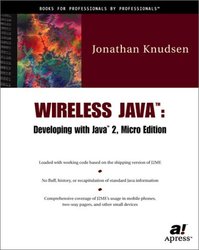買這商品的人也買了...
-
 $615Killer Content: Strategies for Web Content and E-Commerce
$615Killer Content: Strategies for Web Content and E-Commerce -
 $399Core JSP (Paperback)
$399Core JSP (Paperback) -
 $780The Essential Guide to Wireless Communications Applications, The: From Cellular Systems to WAP and M-Commerce (Paperback)
$780The Essential Guide to Wireless Communications Applications, The: From Cellular Systems to WAP and M-Commerce (Paperback) -
 $990XML, XSLT, Java, and JSP: A Case Study in Developing a Web Application (Paperback)
$990XML, XSLT, Java, and JSP: A Case Study in Developing a Web Application (Paperback) -
 Java 資料庫程式設計 (Java Database Programming Bible)
Java 資料庫程式設計 (Java Database Programming Bible)$640$506 -
 JavaServer Pages Pocket Reference
JavaServer Pages Pocket Reference$590$561 -
 Java 經典範例 (Java Examples in a Nutshell, 2/e)
Java 經典範例 (Java Examples in a Nutshell, 2/e)$680$537 -
 Apache Administrator's Handbook
Apache Administrator's Handbook$1,560$1,482 -
 Thinking in Java 中文版 (Thinking in Java, 2/e)
Thinking in Java 中文版 (Thinking in Java, 2/e)$920$727 -
 極端軟體製程--探索篇 (Extreme Programming Explored)
極端軟體製程--探索篇 (Extreme Programming Explored)$350$277 -
 SNMP 網管實務 (Essential SNMP)
SNMP 網管實務 (Essential SNMP)$560$442 -
 Web 好色-網頁色彩學
Web 好色-網頁色彩學$420$328 -
 C++ 設計新思維 (Modern C++ Design: Generic Programming and Design Patterns Applied)
C++ 設計新思維 (Modern C++ Design: Generic Programming and Design Patterns Applied)$650$514 -
 JBuilder 實用技術手冊
JBuilder 實用技術手冊$600$474 -
 802.11 無線區域網路通訊協定及應用
802.11 無線區域網路通訊協定及應用$550$435 -
 Linux C/C++ 網路程式設計
Linux C/C++ 網路程式設計$450$383 -
 JDBC 資料庫程式設計
JDBC 資料庫程式設計$580$493 -
 學伺服端 Java 技術的第1本書
學伺服端 Java 技術的第1本書$280$218 -
 JavaScript 網頁製作徹底研究第2版
JavaScript 網頁製作徹底研究第2版$580$522 -
 Java 與樣式實作
Java 與樣式實作$520$411 -
 JavaServer Pages 動態網頁設計 (JavaServer Pages, 2/e)
JavaServer Pages 動態網頁設計 (JavaServer Pages, 2/e)$450$356 -
 P2P 下載整理無所不包
P2P 下載整理無所不包$299$236 -
 UML For Java Proframmers 中文版:靈活運用 UML 開發 Java 程式 (UML For Java Programmers)
UML For Java Proframmers 中文版:靈活運用 UML 開發 Java 程式 (UML For Java Programmers)$460$363 -
 Borland JBuilder 2005 進階技術手冊
Borland JBuilder 2005 進階技術手冊$580$458 -
 密碼學實務 (Practical Cryptography)
密碼學實務 (Practical Cryptography)$480$379
商品描述
Despite Java’s incredible popularity, the standard edition of Java is way too big and way too bulky to build wireless applications geared towards devices such as the Palm or cell phones. Sun’s answer to this shortcoming was the release of "Java 2 Micro Edition" (J2ME). J2ME has the potential to be as revolutionary in the wireless space as Java has been in the server space. This is the first book that uses the current version of J2ME to give real code for real applications, including extensive coverage of the new and exciting concept of "MIDlets".
Knudsen begins his comprehensive foray into wireless Java programming with an introduction of J2ME, the Mobile Information Device Profile (MIDP), MIDP applications (MIDlets), and a comparative discussion of the differences and similarities between the J2ME and JavaTM Standard Edition APIs. These introductions set the stage for an ample investigation of the creation of both simple and advanced user interfaces, including demonstrations of how to manage the device’s screen, interact with users through event handlers, and create forms and gather user data. An additional chapter explores MIDlet’s capabilities in interaction with the Internet over HTTP.
Knudsen concludes the book with chapters devoted to persistent storage on a device, creating a gaming application, performance tuning, and integrating XML functionality into wireless Java applications.
Contents
Preface
- Chapter 1: Introduction
- Chapter 2: Building MIDlets
- Chapter 3: All About MIDlets
- Chapter 4: Almost the Same Old Stuff
- Chapter 5: Creating a User Interface
- Chapter 6: Lists and Forms
- Chapter 7: Persistent Storage
- Chapter 8: Connecting to the World
- Chapter 9: Programming a Game Interface
- Chapter 10: Performance Tuning
- Chapter 11: Parsing XML
- Chapter 12: Protecting Network Data
- Appendix A: MIDP API Reference
商品描述(中文翻譯)
儘管 Java 擁有驚人的人氣,但標準版的 Java 對於構建針對 Palm 或手機等設備的無線應用程式來說,實在是過於龐大和笨重。Sun 對此缺陷的解決方案是推出「Java 2 Micro Edition」(J2ME)。J2ME 在無線領域的潛力,可能與 Java 在伺服器領域的革命性影響相當。本書是第一本使用當前版本的 J2ME,提供實際應用程式的真實代碼,並廣泛涵蓋了新穎且令人興奮的「MIDlets」概念。
Knudsen 開始全面探討無線 Java 程式設計,首先介紹 J2ME、行動資訊設備配置檔(MIDP)、MIDP 應用程式(MIDlets),以及 J2ME 與 JavaTM 標準版 API 之間的差異與相似之處的比較討論。這些介紹為深入研究簡單和進階使用者介面的創建奠定了基礎,包括如何管理設備螢幕、通過事件處理器與使用者互動、創建表單並收集使用者數據的示範。另一章節探討了 MIDlet 在透過 HTTP 與互聯網互動的能力。
Knudsen 在書的結尾以幾個章節總結,專注於設備上的持久儲存、創建遊戲應用程式、性能調優,以及將 XML 功能整合到無線 Java 應用程式中。
**內容**
前言
- 第 1 章:介紹
- 第 2 章:構建 MIDlets
- 第 3 章:所有關於 MIDlets
- 第 4 章:幾乎是舊的東西
- 第 5 章:創建使用者介面
- 第 6 章:列表和表單
- 第 7 章:持久儲存
- 第 8 章:連接世界
- 第 9 章:編程遊戲介面
- 第 10 章:性能調優
- 第 11 章:解析 XML
- 第 12 章:保護網路數據
- 附錄 A:MIDP API 參考










